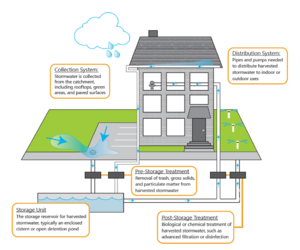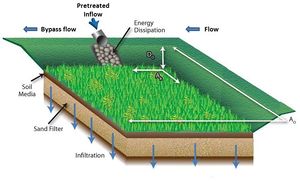
Calculating credits for stormwater and rainwater harvest and use/reuse
This page will be developed in Winter, 2016
| Recommended pollutant removal efficiencies, in percent, for infiltration BMPs. Sources. TSS=total suspended solids; TP=total phosphorus; PP=particulate phosphorus; DP=dissolved phosphorus; TN=total nitrogen | |||||||
| TSS | TP | PP | DP | TN | Metals | Bacteria | Hydrocarbons |
| Pollutant removal is 100 percent for the volume that is captured and infiltrated | |||||||
Credit refers to the quantity of stormwater or pollutant reduction achieved either by an individual Best Management Practice (BMP) or cumulatively with multiple BMPs. Stormwater credits are a tool for local stormwater authorities who are interested in
- providing incentives to site developers to encourage the preservation of natural areas and the reduction of the volume of stormwater runoff being conveyed to a best management practice (BMP);
- complying with permit requirements, including antidegradation (see [1]; [2]);
- meeting the MIDS performance goal; or
- meeting or complying with water quality objectives, including Total Maximum Daily Load (TMDL) Wasteload Allocations (WLAs).
This page provides a discussion of how infiltration practices can achieve stormwater credits. Infiltration practices include infiltration basins, infiltration trenches (including dry wells), and underground infiltration systems. The discussion does not include bioinfiltration and permeable pavement systems, unless specifically mentioned. To view the credit articles for other BMPs, see the Related pages section.
Contents
Overview
Stormwater and rainwater harvest and use/reuse systems capture and store runoff. The stored water is typically utilized for irrigation. This water is assumed to infiltrate. Credits for these BMPs are therefore similar to credits for other infiltration practices in that all water applied for irrigation and pollutants in that water are credited. The methodology differs, however, in that the water is captured instantaneously, but use of the water is dependent on the irrigation rate rather than the soil infiltration rate, as is the case with infiltration BMPs. The period of use is also during the growing season, meaning the generated credits only apply at that time. If harvested water is used indoors, it may be discharged to a sewer system, to a septic drainfield, or to another stormwater BMP. Credits for these vary and are discussed below.
Pollutant removal mechanisms
Infiltration practices reduce stormwater volume and pollutant loads through infiltration of the stormwater runoff into the native soil. Infiltration practices also can remove a wide variety of stormwater pollutants through secondary removal mechanisms including filtration, biological uptake, and soil adsorption through plantings and soil media (WEF Design of Urban Stormwater Controls, 2012). See Other Pollutants, for a complete list of other pollutants addressed by infiltration practices.
Location in the treatment train
Stormwater Treatment Trains are comprised of multiple Best Management Practices that work together to minimize the volume of stormwater runoff, remove pollutants, and reduce the rate of stormwater runoff being discharged to Minnesota wetlands, lakes and streams. The position of a harvest and use/reuse system in a treatment train is a function of the surface from which the water is being collected. Rainwater harvest systems, which are designed to collect water from rooftops, will generally be located near the beginning of the treatment train, while systems that store water in ponds will be located near the end of treatment trains.
Methodology for calculating credits
This section describes the basic concepts and equations used to calculate credits for volume, Total Suspended Solids (TSS) and Total Phosphorus (TP). Specific methods for calculating credits are discussed later in this article. If harvest water is being infiltrated, this practice is also effective at reducing concentrations of other pollutants including nitrogen, metals, bacteria, and hydrocarbons. This article does not provide information on calculating credits for pollutants other than TSS and TP, but references are provided that may be useful for calculating credits for other pollutants.
Assumptions and approach
In developing the credit calculations, it is assumed the harvest and use/reuse system is properly designed, constructed, and maintained in accordance with the Minnesota Stormwater Manual. If any of these assumptions is not valid, the BMP may not qualify for credits or credits should be reduced based on reduced ability of the BMP to achieve volume or pollutant reductions. For guidance on design, construction, and maintenance, see Stormwater and rainwater harvest and use/reuse
In the following discussion, the water quality volume (VWQ) is delivered instantaneously to the BMP. VWQ is stored in a cistern or a pond. VWQ can vary depending on the stormwater management objective(s). For construction stormwater, VWQ is 1 inch off new impervious surface. For MIDS, VWQ is 1.1 inches.
The approach in the following sections is based on the following general design considerations:
- Credit calculations presented in this article are for both event and annual volume and pollutant load removals.
- Stormwater volume credit equates to the volume of runoff that will ultimately be infiltrated into the soil.
- TSS and TP credits are achieved for the volume of runoff that is infiltrated.
Volume Credit Calculations
Volume credits are calculated based on the capacity of the BMP and its ability to permanently remove stormwater runoff via infiltration into the underlying soil from the existing stormwater collection system. These credits are assumed to be instantaneous values. However, unlike other stormwater infiltration practices, for an irrigation system, the volume credit is a function of both the water available for storage, the rate at which water is applied, and the area over which the water is applied.
entirely based on the capacity of the BMP to capture, store, and transmit water in any storm event. Because the volume is calculated as an instantaneous volume, the water quality volume (VWQ) is assumed to pond below the overflow elevation and above the bioretention media. This entire volume is assumed to infiltrate through the bottom of the BMP. The volume credit (Vinfb) for infiltration through the bottom of the BMP into the underlying soil, in cubic feet, is given by
Vinfb=Do (AO+AM) /2
where
- AO is the overflow surface area of the bioretention system, in square feet;
- AM is the area at the surface of the media, in square feet; and
- Do is the ponded depth with the BMP, in feet.
If native soils are used rather than engineered media, the term AM may be substituted by AB, as shown in the above schematic and in the schematics for the MIDS calculator. To comply with the Construction Stormwater General Permit, VWQ must infiltrate within 48 hours (24 hours is recommended if discharges are to a trout stream).
Some of the VWQ will be lost to evapotranspiration rather than all being lost to infiltration. In terms of a water quantity credit, this differentiation is unimportant, but it may be important if attempting to calculate actual infiltration into the underlying soil.
The annual volume captured and infiltrated by the BMP can be determined with appropriate modeling tools, including the MIDS calculator. Example values are shown below for a scenario using the MIDS calculator. For example, a permeable pavement system designed to capture 1 inch of runoff from impervious surfaces will capture 89 percent of annual runoff from a site with B (SM) soils.
Annual volume, expressed as a percent of annual runoff, treated by a BMP as a function of soil and Water Quality Volume. See footnote1 for how these were determined.
Link to this table
| Soil | Water quality volume (VWQ) (inches) | ||||
|---|---|---|---|---|---|
| 0.5 | 0.75 | 1.00 | 1.25 | 1.50 | |
| A (GW) | 84 | 92 | 96 | 98 | 99 |
| A (SP) | 75 | 86 | 92 | 95 | 97 |
| B (SM) | 68 | 81 | 89 | 93 | 95 |
| B (MH) | 65 | 78 | 86 | 91 | 94 |
| C | 63 | 76 | 85 | 90 | 93 |
1Values were determined using the MIDS calculator. BMPs were sized to exactly meet the water quality volume for a 2 acre site with 1 acre of impervious, 1 acre of forested land, and annual rainfall of 31.9 inches.
Related pages
- Overview for stormwater and rainwater harvest and use/reuse
- Design criteria for stormwater and rainwater harvest and use/reuse
- Construction specifications for stormwater and rainwater harvest and use/reuse
- Operation and maintenance for stormwater and rainwater harvest and use/reuse
- Water quality considerations for stormwater and rainwater harvest and use/reuse
- Environmental concerns for stormwater and rainwater harvest and use/reuse
- Cost-benefit considerations for stormwater and rainwater harvest and use/reuse
- Case studies for stormwater and rainwater harvest and use/reuse
- Calculating credits for stormwater and rainwater harvest and use/reuse
- Definitions for stormwater and rainwater harvest and use/reuse
- Requirements, recommendations and information for using Harvest and re-use/cistern as a BMP in the MIDS calculator
- Links for stormwater and rainwater harvest and use/reuse
- References for stormwater and rainwater harvest and use/reuse
- Technical support for stormwater and rainwater harvest and use/reuse

